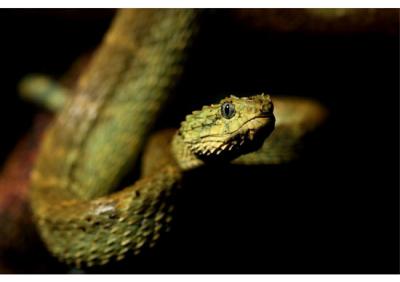
Credit: Benjamin Tapley.
An international collaboration led by scientists from the National University of Ireland, Galway, The University of St Andrews, Trinity College Dublin and the Zoological Society of London has uncovered why the venom of some snakes makes them so much deadlier than others.
Snakes are infamous for possessing potent venoms, a fact that makes them deadly predators and also strikes fear into humans and other animals alike. However, some species, such as cobras, boomslangs and rattlesnakes have far more venom than they apparently need–in a single reserve of venom, they have the potential to kill thousands of their prey animals and several adult humans.
But not all venomous snakes are so dangerous. For example, the marbled sea snake has only a tiny amount of very weak venom, making it effectively harmless to any relatively large animals such as humans. Why venoms vary so much in their ability to kill or incapacitate potential prey animals has long puzzled scientists, with several competing hypotheses suggested as explanations.
The study, which has just been published in international journal Ecology Letters, tackled this puzzle by comparing records of venom potency and quantity for over 100 venomous snake species, ranging from rattlesnakes, cobras and the tree dwelling boomslangs of Africa to sea snakes and burrowing asps. The team found strong evidence that venoms have evolved to be more potent against animals that are closely related to the species that the snake commonly eats.
Dr Kevin Healy, who conducted the research at the University of St Andrews and is now Lecturer of Zoology at the National University of Ireland Galway, is the lead author of the study. He said: “These results make sense from an evolutionary viewpoint as we expect that evolution will have shaped venoms to be more efficient at killing the prey animals they are most often the target of the venom. You won’t find many mice in the sea so we wouldn’t expect a sea snake to evolve venom that is more effective at killing mice than fish.”
The research also showed that the amount of venom a snake has depends on both its size and the environment it lives in.
“Like all substances venom is dosage-dependent,” said Associate Professor in Zoology at Trinity College Dublin, Dr Andrew Jackson. “Even alcohol, coffee and water can be toxic at high enough volumes so we needed to consider how much venom different species of snake produce and store in their venom glands. We found that big terrestrial species have the most venom, while smaller tree dwelling or aquatic species had the least. This difference may be due to how often a snake encounters its prey in these different environments, with terrestrial species requiring a larger reserve of venom to take advantage of the rarer opportunities to feed.”
The results of the study also have potential to aid in our understanding when it comes to human snakebites.
“Snakebites are a major health concern worldwide, with 2.7 million cases each year,” commented Dr Chris Carbone of the Institute of Zoology in the Zoological Society of London. “Understanding how venom evolves may help us better identify the risks to humans from different snake groups, and also potentially from other venomous animals such as spiders, scorpions, centipedes and jellyfish.”
The approach used in the study may also help researchers predict the potency of venoms in species that have yet to be tested, and even pinpoint potentially useful healthcare-related applications.
Dr Healy added: “The next step is to see how well this model may predict the potency of venoms in groups that have yet to have their venoms tested. By using ecological and evolutionary data for available species we may be able to use our approach as a tool to identify other species which may have properties in their venoms that are useful for biomedical purposes, such as drug development.”
###
Media Contact
Thomas Deane
[email protected]
353-189-64685
Related Journal Article
http://dx.




